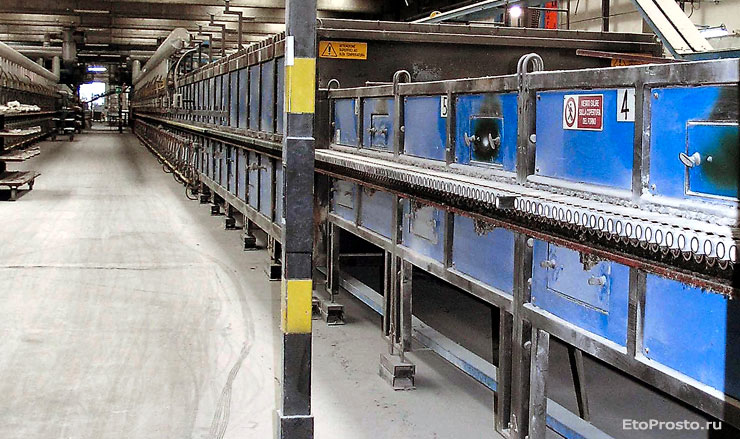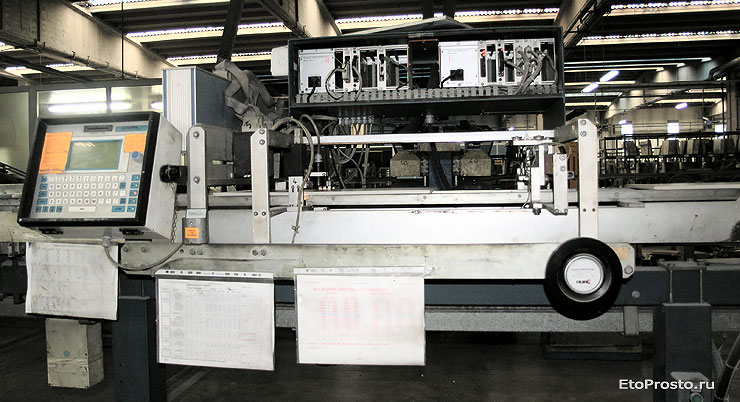

Do you know that when you buy a tile of 30x30 cm dimension, for example, its real size will almost certainly never be 30x30 cm? It can take such dimensions as 29.8х29.8 cm, 30.2х30.2 cm, 29.5х29.5 cm – the options can be quite many. A tile of size 20x20 cm can have the size 19.7x19.7 cm, a porcelain stoneware of size 60x60 cm can be 60.8x60.8 cm in size. This is normal and not a defect or deception by the seller. This situation is most common with floor tiles and porcelain stoneware. We will explain why as you read further.
The reason is that tiles are made from clay, and clay – to the infinite sorrow of all manufacturers – tends to shrink during baking. Controlling the degree of compression of clay is a serious headache for many factories because too much compression can cause the tile to be deformed and become curved. Therefore, the production process in brief is as follows:
- the tile – a raw product with a size bigger than you need to get at the end – is loaded into the production line
- its composition is mixed with calcium-containing substances (wollastonites, fly ash or blast furnace slag), which do not shrink during baking. They help to reduce the compression of clay tiles
- the tile is slowly baked in a chain of blast furnaces. The temperature in each subsequent furnace is higher than in the previous one. After the furnace with the maximum temperature (for porcelain stoneware it is about 1300 °C), the temperature in each subsequent furnace is reduced in order to avoid thermal shock and deformation of the tile. Decent factories spend a huge lot of money on this procedure, given the current cost of energy
 |
| The photo above shows the production line consisting of a set of furnaces |
The higher the temperature, the higher the extent of compression. Therefore, the problem associated with ensuring the right caliber mainly exists for porcelain stoneware and floor tiles, which are baked at a higher temperature. Doubled-fired tiles usually have one caliber – the have lesser compression and before the second firing, the batch is checked to ensure a uniform size.
- based on settings in the equipment, the baking duration, type of clay, temperature, presence of additional impurities and good luck, the factory workers hope to get at the end a tile with the right size, for example, 30x30 cm. In this case, size 30x30 cm will be the nominal size specified in all catalogs and documents
- actually, something different comes out of the furnace every time. Sometimes more and sometimes less than expected. Clay is a natural product extracted from the ground at various fields, and its properties can vary from batch to batch. That is why the degree of compression of clay differs and thus you sometimes get 29.7х29.7 cm, and sometimes 30.2x30.2 cm
- therefore decent factories place a special measuring module on the production line, which uses a laser to measure the sizes of the tiles coming down from the conveyor, and sorts the tiles by size. The machines shown below are performing this operation:
 |
Tiles of size 29.7х29.7 cm are sorted as first size, 29.8х29.8 cm as another size, 29.9х29.9 cm as the third, etc. These sizes are called caliber. Most often, the difference between calibers is 1 mm. The difference between the tiles manufactured in one series may be up to a centimeter. Hence, under a nominal size of 30x30 cm, the actual size of the tile will vary from 29.5х29.5 cm to 30.5х30.5 cm. The first caliber takes the smallest size, the second caliber takes the next size (greater by 1 millimeter), etc.
A tile from the same collection but with different calibers looks like this:
.jpg) |
| The photo above shows a tile of two different calibers of the same collection of size 20x20 cm |
- Tiles of a single caliber are packed in each box. The caliber is indicated on the packaging. (Dishonest factories may not sort the tiles but rather load different sizes into one box. This is often done by the Chinese)
Now, at the exit you have N boxes of caliber 1, M boxes of caliber 2, Y boxes of caliber 3, etc.
What happens next?
Once the tiles are ready to be packaged, distributors from different countries enthusiastically place orders to buy them from the factory (of course tiles of the same caliber, for example, K). If the tiles are beautiful, the distributors sell them quickly and soon begin to run out of stock. Joyful traders, rubbing their hands in anticipation of profit, place another order with the factory, and what next? Tiles of the previous caliber are no more remaining at the factory because other "smart " distributors have bought them all. However, the factory has tiles of another caliber (K + x). The distributor has no choice but to take the new caliber since tiles are a fast-moving product. However, it may be that the distributor still has in stock a certain quantity of tiles with the previous caliber (K), which also have to be sold. Now here comes a very important moment
- a decent shop will sell both caliber separately or warn buyers that different calibers may be included together.
- a dishonest shop will sell tiles of different calibers to a naive buyer without warning. Moreover, this information may be well indicated in the shipping documents, and you may even sign them, not realizing what is at stake, and then receive tiles of different calibers.
What are the problems this can cause?
It is still possible to lay together tiles of 2 adjacent calibers (for example, 29.9х29.9 and 29.8х29.8) using tile-to-tile joints as a compensation, but it is almost impossible to lay together tiles of distant calibers (for example, caliber 3 and 8). This can only be achieved on different surfaces or through a separator, changing the pattern. Be sure to check the documents when buying and you may verify from the seller whether all the tiles to be delivered have the same caliber.
Why is it even better to know the tile caliber when buying tiles?
It is best to buy tiles with a reserve for many reasons. See the article Different tile shades, or why it is dangerous to buy additional tiles 2 years later. Nevertheless, there are cases where, due to financial constraints, you try to calculate the size of the material without leaving room for any reserve, in addition, considering each undercutting. Now, imagine that you have 36 meters and you are buying a tile of 60x60 cm. Not knowing the calibers and the exact size, it is logical to buy 100 (36/(0.6х0.6) tiles. Knowing that the exact tile size is 60.8x60.8, you would have purchased only 98 (36/(0.608x0.608) tiles. If the exact size turns out to be smaller, then the tiles will simply not be enough for you. Frankly speaking, a normal store will calculate everything right for you and still offer a reserve. However, if you are doing the calculations yourself, then take into account the caliber.
If for some reason you are buying additional tiles, ask the seller to give you the same caliber (and the same shade, see the article Different tile shades, or why it is dangerous to buy additional tiles 2 years later) that the first tile had. Иначе вы не сможете ее совмещать. Otherwise, you will not be able to combine them. This is especially critical for those cases when you are changing a certain tile in the middle of an installation because the new one may not fit in with the rest or the other way round – gaping holes will remain. If the caliber is not specified in the documents, find it on the tile box, write it down and save (at the same time write down the name of the factory, tile collection, size and shade). If the seller does not have tiles with the required caliber, in some cases, such tiles can be ordered from the factory.
Tiles laid in several formats look beautiful and please the owner (especially the designer) of the apartment. The truth is that not all tiles produced under a single collection in various sizes can be laid together – just because of the very same calibers. If the collection has a tile of, for example, 60x60 cm, 30x30 cm and 30x60 cm, then it can be produced at the factory either on three production lines of the respective appropriate sizes, or small sizes can be derived from larger ones (in this case from 60x60 cm) by cutting.
In the first situation, you need to make sure that all the three sizes are in the same caliber, else they cannot be laid together. (At the same time, make sure that they have the same thickness for you never can tell). If the older tile has caliber 2, then all the rest should also have caliber 2 – well, or in extreme cases, caliber 1 or 3, else you will have yourself tormented.
In the second situation, the younger sizes will be rectified, that is, will have a 90-degree angle. This is so because they were cut and so a smooth edge was sawed off. A straight edge was not sawed off from the largest tiles, so they will not be able to be laid together. In such a situation, it is important to take the older size also rectified (sometimes called seamless). All rectified tiles are usually in one caliber. Therefore, all sizes can easily be laid to form a single pattern. It sounds a bit complicated, but if you have already fallen for multi-format laying, then tire the heart out of the salesperson at the store.
There are quite few ways you can do so. This information is not reflected in the stands at the store, not mentioned in the catalogs and is sometimes not even indicated in shipping documents. The best way is to ask the salesperson at the store (he can verify from the warehouse) or check on the box by yourself (if you have already bought the tile). Most often, the caliber is indicated as a number or as a size in mm (197x197) .
.jpg) |
| In the photo above, the caliber is indicated as a number in 2 places. It shows the exact size of the tile – 246х494.5 mm. Such a tile may be sold in the shop as 25x50 cm. |
Yes, they have. Depending on the configuration of the equipment, the tile can be cut in different ways. But as a rule, a rectified tile can have different calibers between different collections in a particular factory, while inside one collection, all the rectified tiles are in one size. So you can safely buy and not be afraid of anything. Combine sizes as you want and buy additional tiles. The price of a rectified product is of course higher, but the benefits are equally many.
Yes, it can and regularly does so. The only thing is that making customized tiles with the required caliber is very difficult (if only not to cut). But sooner or later, tiles of the same caliber as before will of course come out from the furnace.
Also check the following articles:
Porcelain stoneware: how it is made – a report from the factory





|
Гость ( IP: 193.*.*.89 )
| 19.01.2020 22:23
Thank you for your help. Good to know upfront and not realyzing it after arriving the tiles from the factory
| |
|
|
Гость ( IP: 70.*.*.198 )
| 14.09.2017 06:30
Bravo...exactly what I was looking for. Thank you
| |
|